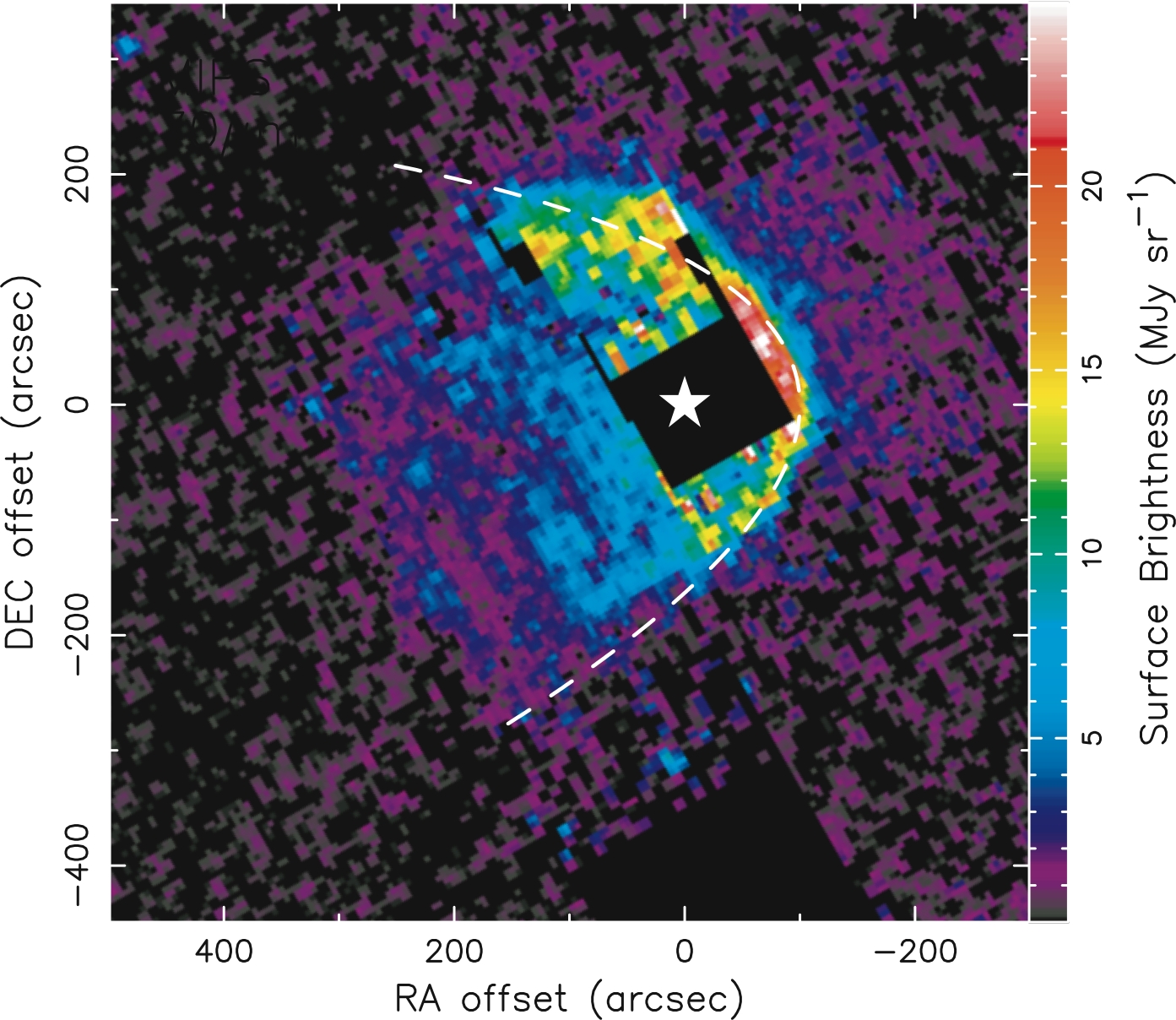







| BOOKS | F. A. Q. | ARTICLES | TALKS | ABOUT KEN | DONATE | BEYOND OUR KEN |
|---|
By Ken Croswell
July 24, 2006

Image by Toshiya Ueta et al., using the Spitzer Space Telescope.
An arc-shaped nebula near the star R Hydrae is the first bow
shock ever seen around a pulsating red giant, say astronomers
using the Spitzer Space Telescope. The bow shock arises as
material streaming off the star slams into the interstellar
medium.
R Hydrae is near the end of its life and is one of the brightest Mira-type variable stars in the sky. As the star expands and contracts, it brightens and fades. When brightest, R Hydrae shines at fifth magnitude, making it visible to the naked eye; but when dimmest, the star can only be seen by using optical aid.
On February 26, 2006, Toshiya Ueta of NASA's Ames Research Center near San Francisco, Angela Speck of the University of Missouri at Columbia, and their colleagues in the United States, Europe, and Japan took aim at R Hydrae with the Spitzer Space Telescope. They discovered far-infrared radiation from a faint nebula located just a quarter of a light-year from the star.
 The image here, from a paper to appear in Astrophysical Journal Letters, shows radiation at 70 microns--a far-infrared
wavelength a hundred times longer than the reddest wavelength the
human eye can see. In the image, red indicates the most intense
radiation, while yellow and green signify weaker radiation. The
white, five-pointed star denotes R Hydrae's position. North is
up and west is to the right.
The image here, from a paper to appear in Astrophysical Journal Letters, shows radiation at 70 microns--a far-infrared
wavelength a hundred times longer than the reddest wavelength the
human eye can see. In the image, red indicates the most intense
radiation, while yellow and green signify weaker radiation. The
white, five-pointed star denotes R Hydrae's position. North is
up and west is to the right.
The image reveals a parabolic nebula that lies west-northwest of the star. The nebula is a tenth of a light-year thick.
Like Mira and other pulsating red giants, R Hydrae sheds material in a so-called wind. The star loses 3 x 10-7 solar masses per year--the equivalent of one Earth mass every decade. Although R Hydrae presumably ejects this mass in all directions, the star is traveling through the interstellar medium at 50 kilometers per second. Furthermore, the star is moving toward the west-northwest. Thus, Ueta and his colleagues believe the nebula represents a bow shock where the red giant's wind smacks into the lower-density material in the interstellar medium.
"The bow shock is a little bit surprising," comments Peter Wood at the Australian National University. Wood notes that R Hydrae will cast off its atmosphere during the next few hundred thousand years, creating a planetary nebula like the Ring Nebula in Lyra--and that most planetary nebulae are fairly round. "So it's a bit of a surprise that the first one of these detected has this bow-shock shape," Wood says.
Ueta and his colleagues estimate that the total amount of material in R Hydrae's nebula is about 1.3 x 10-4 solar masses. That's 14 percent of Jupiter's mass, or 43 times the mass of the Earth.
R Hydrae resides in the largest constellation, Hydra the Water Snake, about 12 degrees south of Spica, the brightest star in Virgo. R Hydrae is roughly 540 light-years from Earth. The star pulsates once every 385 days, but its pulsation period has decreased over the past three centuries. As it sheds its atmosphere, the star will metamorphose from a red giant into a white dwarf.
Ken Croswell is an astronomer and the author of Magnificent Universe, Ten Worlds, and a book for beginning stargazers, See the Stars: Your First Guide to the Night Sky.
"Magnificent Universe by Ken Croswell is elegant and eloquent."--Washington Post. See all reviews of Magnificent Universe here.
"On the basis of its striking design and photographs, this handsome, large-format volume is well worthy of praise. And astronomer Croswell's concise yet conversational, information-packed text wins it sky-high accolades in the narrative sphere as well."--Publishers Weekly, starred review. See all reviews of Ten Worlds here.
"Finally! An astronomy guide that the reader can actually follow without being a rocket scientist!" See all reviews of See the Stars here.
| BOOKS | F. A. Q. | ARTICLES | TALKS | ABOUT KEN | DONATE | BEYOND OUR KEN |
|---|